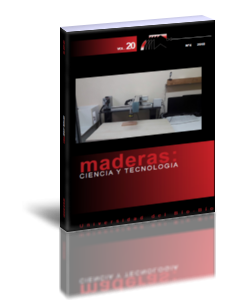Influence of coupling agents on rheological, thermal expansion and morphological properties of recycled poypropylene wood flour composites
Keywords:
Coefficient of thermal expansion, flow activation energy, melt flow index, natural oil, octanoic acidAbstract
In this work, thermal expansion and morphological properties of recycled polypropylene wood flour composites were evaluated in order to verify the effect caused by the usage of a natural oil as coupling agent. The natural oil used as coupling agent was octanoic acid (C8), maleic anhydride grafted polypropylene (MAPP), widely used in industry but from non-renewable source, was also used for comparison. Composites were obtained by twin screw extrusion and injection molded. The results showed that the addition of octanoic acid and maleic anhydride grafted polypropylene reduced the coefficient of thermal expansion of the composites. The dependence of melt viscosity obeyed the Arrhenius-Eyring expression, and the activation energy values for composite viscous flow were higher than matrix. The composite morphology revels that octanoic acid promotes strong interfacial adhesion between filler and matrix, similar to that observed when maleic anhydride grafted polypropylene were used. Octanoic acid showed similar results when compared with maleic anhydride grafted polypropylene in all properties evaluated, indicating that can be used as an alternative instead of use coupling agent from non-renewable sources.
Downloads
References
Cheng, S.; Lau, K.; Liu, T.; Zhao, Y.; Lam, P.M.; Yin Y. 2009. Mechanical and thermal properties of chicken feather fiber/PLA green composites. Composites Part B 40: 650-654.
El-Sabbagh, A. 2014. Effect of coupling agent on natural fibre/polypropylene composites on mechanical and thermal behaviour. Composites Part B 57: 126-135.
Fonseca-Valero, C.; Ochoa-Mendoza, A.; Arranz-Andrés, J.; González-Sánches, C. 2015. Mechanical Recycling and composition effects on the properties and structure of hardwood cellulose-reinforced high density polyethylene eco-composites. Composites Part A 69:94-104.
Freire, C.S.R.; Silvestre, A.J.D.; Pascoal Neto, C.; Gandini, A.; Martin L.; Mondragon, I. 2008. Composites based on acylated cellulose fibers and low-density polyethylene: effect of the fiber content, degree of substitution and fatty acid chain length on final properties. Composites Science and Technology 68: 3358-3364.
Hong, H.; Liao, H.; Zhang, H.; He, H.; Liu, T.; Jia, D. 2014. Significant improvement in performance of recycled polyethylene/wood flour composites by synergistic compatibilization at multi-scale. Composites Part A 64: 90-98.
Hristov, V.; Vlachopoulos, J. 2007. Influence of coupling agents on melt flow behavior of natural fiber composites. Macromolecular Materials and Engineering 292: 608-619.
Huang, H-X.; Zhang, J-J. 2008. Effects of filler-filler and polymer-filler interactions on rheological and mechanical properties of HDPE-wood composites. Journal of Applied Polymer Science 111: 2806-2812.
Khonsari, A.; Taghiyari, H.R.; Karimi, A.; Tajvidi, M. 2015. Study on the effect of wood flour geometry on physical and mechanical properties of wood-plastic composites. Maderas- Cienc Tecnol 17: 545-558.
Kord, B.; Malekian, B.; Yousefi, H.; Najafi, A. 2016. Preparation and characterization of nanofibrillated cellulose/poly (vinylalcohol) composite films. Maderas-Cienc Tecnol 18: 743-752.
Lebrun, G.; Denault, J. 2010. Effect of annealing on the thermal expansion and residual stresses of bidirectional thermoplastic composite laminates. Composite Part A 41: 101-107.
Martins, A.B.; Santana, R.M.C. 2016. Effect of carboxilic acids as compatibilizer agent on mechanical properties of thermoplastic starch and polypropylene blends. Carbohydrate Polymers 135: 79-85.
Muksing, N.; Nithitanakul, M.; Grady, B.P.; Magaraphan, R. 2008. Melt rheology and extrudate swell of organobentonite filled polypropylene nanocomposites, Polymer Testing 27: 470-479.
Nafchi, H.R.; Abdouss, M.; Najaf, S.K.; Gargari, R.M.; Mazhar, M. 2015. Effects of nano-clay particles and oxidized polypropylene polymers on improvement of the thermal properties of wood plastic composite. Maderas-Cienc Tecnol 17: 45-54.
Naghmouci, I.; Espinach, F.X.; Mutjé, P.; Boufi, S. 2015. Polypropylene composites based on lignocellulosic fillers: how the filler morphology affects the composite properties. Materials and Design 65: 454-461.
Nair, K.C.M.; Kumar, R.P.; Thomas, S.; Schit, S.C.; Ramamurthy, K. 2000. Rheological behavior of short sisal fiber-reinforced polystyrene composites, Composite Part A 31: 1231-1240.
Poletto, M.; Zeni, M.; Zattera, A.J. 2012. Effects of wood flour addition and coupling agent content on mechanical properties of recycled polystyrene/wood flour composites. Journal of Thermoplastic Composite Materials 25: 821-833.
Poletto, M. 2017a. Mechanical, dynamic mechanical and morphological properties of composites based on recycled polystyrene filled with wood flour wastes. Maderas-Cienc Tecnol 19: 433-442.
Poletto, M. 2017b. Polypropylene-based wood-plastic composites: effect of using a coupling agent derived from a renewable source. Maderas-Cienc Tecnol 19: 265-272.
Saini, D.R.; Shenoy, A.V. 1983. A new method for the determination of flow activation energy of polymer melt. Journal of Macromolecular Science, Part B 22: 437-449.
Sanap, D.P.; Kadam, K.D.; Narayan, M.; Kasthurirangan, S.; Nemade, P.R.; Dalvi, V.H. 2015. Analysis of saline water desalination by directed solvent extraction using octanoic acid. Desalination 357: 150-162.
Shenoy, A.V.; Saini, D.R.; Nadkarni, V.M. 1983. Rheograms for engineering thermoplastics from melt flow index. Rheologica Acta 22: 209-222.
Shenoy, A.V. 1999. Rheology of filled polymer systems. Kluwer Academic Publishers, The Netherlands.
Singh, S.; Mohanty, A.K. 2007. Wood fiber reinforced bacterial bioplastic composite: fabrication and performance evaluation. Composite Science and Technology 67: 1753-1763.
Spoljaric, S.; Genovese, A.; Shanks, R.A. 2009. Polypropylene-microcrystalline cellulose composites with enhanced compatibility and properties. Composites Part A 40: 791-799.
Teuber, L.; Osburg, V.S.; Toporowski, W.; Militz, H.; Krause, A. 2016. Wood polymer composites and their contribution to cascading utilization. Journal of Cleaner Production 110: 9-15.
Tufan, M.; Akbaş, S.; Aslan, M. 2016. Decay resistance, thermal degradation, tensile and flexural properties of sisal carbon hybrid composites. Maderas-Cienc Tecnol 18: 509-606.
Turku, I.; Keskisaari, A.; Kärki, T.; Puurtinen, A.; Marttila, P. 2017. Characterization of wood plastic composites manufactured from recycled plastic blends. Composite Structures 161: 469-476.
Wang, Q.; Lei, J.; Ma, J.; Yuan, G.; Sun, H. 2018. Effect of chitosan-carvacrol coating on the quality of Pacific white shrimp during iced storage as affected by caprylic acid. International Journal of Biological Macromolecules 106: 123-129.j
Yuan, Q.; Wu, D.; Gotama, J.; Bateman S. 2008. Wood fiber reinforced polyethylene and polypropylene composites with high modulus and impact strength. Journal of Thermoplastic Composite Materials 2008; 21:195–208.

































